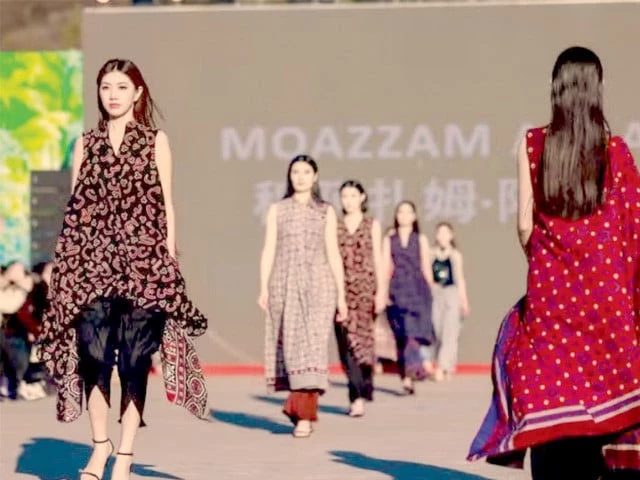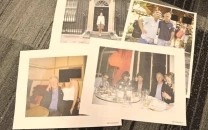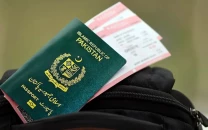Fashion meets friendship on the Great Wall
First Pakistan-China fashion show transforms diplomacy into design, celebrating six decades of cultural exchange with

When Professor Cheng Xizhong of Beijing's Charhar Institute called Pakistan's recent fashion shows in China "a unique ecosystem where cultural dissemination and commercial value exist symbiotically," he wasn't indulging in polite diplomatic phrasing. His words captured the pulse of a phenomenon that has grown beyond mere pageantry into an intricate dance of tradition, artistry, and strategic friendship between two old allies.
Over the past few years, Pakistan's fashion ventures in China have evolved into far more than displays of fabric and form. They have become expressions of cultural identity and economic ambitioncarriers of a story that threads centuries-old craftsmanship with modern design sensibilities.
According to Prof Cheng, these shows have achieved "great success on a dual dimensionthrough business achievements and cultural resonance." That balance, he says, is precisely what makes Pakistan's fashion outreach exceptional: it merges commerce with cultural diplomacy, presenting textiles not merely as trade goods but as symbols of creative heritage and national confidence.
The most recent displays, particularly those held in Shanghai and Beijing, have reaffirmed this transformation. In these cities, Pakistani designers have turned runways into storytelling platforms where embroidery patterns whisper history and silhouettes reflect a new age of global relevance.
Prof Cheng observed that Pakistan's presence on the Chinese fashion scene is "a window for conveying cultural confidence," and indeed, confidence is the very fabric of the country's creative narrative.
That narrative reached breath-taking new heights this October when the Pakistan-China Fashion Show took over one of the most iconic landmarks on Earththe Great Wall of China. Against the majestic backdrop of Badaling, fashion, culture, and diplomacy converged in dazzling unity. The event, co-organised by the Pakistan Embassy in Beijing and the China International Cultural Communication Center (CICCC), was the first of its kind to grace the historic stone pathway.
Under the evening sky, the Great Wall's ancient stones reflected the shimmer of silk and the rhythm of friendship. Pakistani designers Maheen Khan, Moazzam Abbasi, Ayesha Tariq, Rizwaullah, and Zain Hashmi presented collections that married Pakistani craftsmanship with Chinese artistic influence. Each ensemble celebrated a fusionof texture, motif, and meaningturning the catwalk into a cultural dialogue in motion.
China-based Pakistani designer Aqeel Chaudhary contributed a jewellery collection that echoed eastern refinement with a contemporary flair, while renowned Chinese designer Liang Suyun's creations added poetic symmetry to the evening. Adnan Ansari of Riwayat, the show's curator, orchestrated the fusion seamlessly, framing the event under a powerful idea"fashion as a bridge between cultures."
Pakistan's Ambassador to China, Khalil Hashmi, used the occasion to highlight the event's layered symbolism. Standing before an audience of diplomats, Chinese officials, and business leaders, he called the Great Wall venue "a befitting site to celebrate the living spirit of the Silk Road connection, now manifested as a modern bridge of fabric, art, and friendship."
But beneath the glamour and applause, the deeper resonance of such events lies in their ability to turn artistic collaboration into sustained economic opportunity. Prof. Cheng emphasised this aspect, pointing out that "the success of the Pakistani fashion shows is reflected in the practical results of trade conversion."
Pakistan, one of the world's leading cotton producers, has been using exhibitions as strategic gateways to expand into international markets, particularly China's vast consumer base. Dozens of Pakistani enterprises, representing the entire textile chainfrom premium fabrics to functional yarnshave participated in these shows, reaping both exposure and contracts.
The Shanghai chapter of this creative diplomacytitled 'Silk Road Elegance: Two Nations, One Runway' showcased this synergy vividly. The event, held on October 17, blended Pakistani artistry with Chinese aesthetics in four distinct segments, each reflecting a facet of Pakistan's design evolution.
Maheen Khan's collection drew from vibrant truck art, combining it with couture techniques to produce garments that were both playful and sophisticated. Moazzam Abbasi paid tribute to Sindh's Ajrak tradition through eco-conscious cotton pieces dyed in natural pigments. Jewellery brand Winza presented emeralds from Swat Valley in exquisite bridal and gemstone collections that shimmered with Pakistani craftsmanship.
The finale, courtesy of The Factory Edit, underscored sustainabilitya global concern now entering South Asia's creative discourse. Its upcycled designs, crafted from waste materials, proved that elegance and environmental awareness can indeed walk the same ramp.
CICCC Chairman Long Yuxiang described the Great Wall fashion show as "a vivid reflection of the China-Pakistan All-Weather Strategic Cooperative Partnership," adding that it embodied not only aesthetic appreciation but also a shared desire to pursue better lives through fashion.
He expressed confidence in deepening collaboration to explore "the contemporary value of traditional aesthetics" and to inject "new vitality" into the fashion dialogue between the two nations.
In a world where soft power increasingly determines international influence, these events serve as subtle yet potent diplomatic instruments. Fashion, after all, carries no language barrier. A well-cut silhouette or handwoven motif can communicate identity, aspiration, and goodwill more powerfully than many political statements. By transforming its textile heritage into a cultural export, Pakistan has turned fabric into foreign policy.
As Prof Cheng noted, Pakistani fashion "demonstrates not only exquisite craftsmanship but also remarkable design capability," making it both a commercial and cultural revelation for Chinese audiences. He stressed that these exchanges are "infused with the emotional background of China-Pakistan friendship," giving them a warmth that transcends business.
From the Great Wall's ancient stones to Shanghai's modern skylines, a new Silk Road is indeed being woventhread by thread, design by designinto a shared fabric of trust, creativity, and vision. As applause fades and lights dim, what remains is the enduring image of two nations walking the same runway, hand in hand, toward a beautifully tailored future.




















COMMENTS
Comments are moderated and generally will be posted if they are on-topic and not abusive.
For more information, please see our Comments FAQ